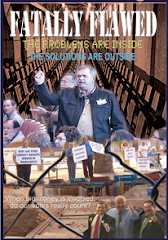August 11, 2009 (A Special Report)
Consortium News
False Republican claims about President Barack Obama’s health-care initiative, including former Alaska Gov. Sarah Palin’s demagogic charge about a “death panel,” are part of a pattern of systematic lying that has marked the GOP’s political tactics at least since Ronald Reagan’s presidency in the 1980s.
Indeed, to understand how the war against health-care reform is gaining traction, you must look back three decades to the dawn of this Republican era of pervasive deception.
It was during the early Reagan administration that it hit me that falsifying reality was no longer an aberration for Republicans – something done by a politician caught in a tight spot or a debater spinning a losing argument – but had become part and parcel of GOP strategy.
Not that Democrats and other politicians don’t lie or dissemble, too. As a reporter for the Associated Press, I had encountered devious politicians of various stripes while covering Rhode Island politics and Washington’s Capitol Hill in the mid-to-late 1970s.
But something new was afoot in the early 1980s. Republicans were adopting a conscious approach to deception that was qualitatively different from what was common in politics. With the aid of a growing right-wing media, the GOP covered up ghastly crimes by its allies and enflamed public opinion against its adversaries, regardless of the facts.
I first confronted this pattern while covering Reagan’s hard-line policies toward Central America. The lies started just weeks after Reagan’s 1980 election, when four American churchwomen were raped and murdered by government security forces in rightist-ruled El Salvador.On the night of Dec. 2, 1980, two of the women, Dorothy Kazel and Jean Donovan, drove a white mini-van to the international airport outside San Salvador. There, they picked up Ita Ford and Maura Clarke who had attended a conference in Nicaragua.Leaving the airport, the van turned onto the road that heads into the capital city. At a roadblock, a squad of soldiers stopped the van and took the women into custody. After a phone call apparently to a superior officer, the sergeant in charge said the orders were to kill the women. The soldiers raped them first and then executed the women with high-powered rifles.The atrocity was only one of hundreds committed each month by the Salvadoran security forces in a “dirty war” against leftists and their suspected supporters, a conflict that was more mass murder than a war, a butchery that would eventually claim some 70,000 lives. The Dec. 2 atrocity stood out only because Americans were the victims.The proper response from U.S. officials would have seemed obvious: to join U.S. Ambassador Robert White in denouncing the brutal rape and murder of four American citizens. But the incoming Reagan foreign policy team didn’t see it that way; Reagan was on the side of the rightist Salvadoran military.So, the rape-murder was treated like a public relations problem, best handled by shifting blame onto the victims. Jeane Kirkpatrick, Reagan’s choice for United Nations ambassador, depicted the victims as “not just nuns. The nuns were political activists – on behalf of the [leftist opposition] Frente.”Kirkpatrick's implication was that it wasn’t all that bad to rape and murder “political activists.”
A Shoot-Out? (Next)
For the rest of the story click here.
















